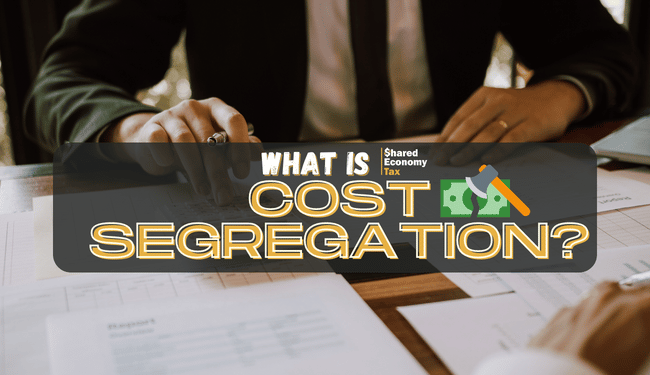11:46:46 pm 10/16/2023
Viewed: 4583
Maximizing Tax Benefits: Cost Segregation and Bonus Depreciation Explained
Real estate investment comes with its own set of financial perks, and one of the most significant benefits is the ability to reduce your taxable income through cost segregation and bonus depreciation. These strategies allow investors to accelerate the depreciation of assets and claim substantial tax deductions. In this article, we'll break down the concepts of cost segregation and bonus depreciation and how they can be powerful tools for real estate investors.
Depreciation Basics:
Depreciation is the gradual allocation of the initial cost of an asset against your taxable income over its useful life. For residential real estate, this period is typically 27.5 years, while for commercial real estate, it's 39 years. Each year, you can deduct a percentage of the asset's value from your taxes. For residential properties, it's around 3.63%, and for commercial properties, it's approximately 2.56%.
Example:
Let's say you own a residential building worth $1 million. Each year, you can deduct approximately $36,300 ($1,000,000 / 27.5 years) from your taxable income, reducing your tax liability.
Basis and Capital Investments:
The basis is the initial investment amount for tax purposes. Any capital investments, such as roof replacements or buying adjacent parcels, increase your basis. However, operational expenses can't be fully deducted in the year they occur. As you deduct depreciation each year, your basis decreases.
Example:
If you bought a property for $1 million and deducted $25,641 each year, your basis would drop from $1 million to $975,000. If you later sold the property for $1 million, your taxable gain would be $25,000 ($1 million - $975,000).
Accelerated Depreciation:
Not all assets have the same depreciation timeline. Some assets, like sidewalks, have shorter useful lives, as determined by the IRS. Investors can assign values to these assets and depreciate them faster, over a shorter period, resulting in larger tax deductions early on.
Bonus Depreciation:
Bonus depreciation is a special provision in the tax code that allows you to deduct a percentage of the asset's cost in the first year it's put into service. Currently, you can write off 100% of the value of assets with a useful life of 15 years or less. This percentage may vary based on tax code changes.
Example:
If you purchase assets like landscaping, doors, or appliances with a 15-year or shorter useful life, you can deduct their full value in the first year.
Cost Segregation Studies:
To take full advantage of bonus depreciation, real estate investors often hire consultants to perform cost segregation studies. These studies allocate values to various assets on a depreciation schedule. A significant portion of the purchase price can be deducted in the first year, resulting in substantial tax savings.
Example:
Imagine you buy a $3 million self-storage facility and a cost segregation study identifies $700,000 in assets with a 15-year or shorter useful life. Bonus depreciation allows you to deduct 30% of the purchase price in the first year.
Tax Benefits and Future Investments:
These deductions from bonus depreciation can offset income from other properties in the same income category. This tax planning strategy can lead to significant tax savings and encourage further real estate investments.
In Conclusion:
Cost segregation and bonus depreciation are powerful tools in the real estate investor's toolbox. They enable investors to reduce their taxable income substantially, especially in the early years of property ownership. While some accountants may be cautious about these strategies, the benefits often outweigh the potential recapture of taxes in the future. It's essential to work with professionals who understand the nuances of real estate tax planning and can help you maximize your returns.
Real estate investment comes with its own set of financial perks, and one of the most significant benefits is the ability to reduce your taxable income through cost segregation and bonus depreciation. These strategies allow investors to accelerate the depreciation of assets and claim substantial tax deductions. In this article, we'll break down the concepts of cost segregation and bonus depreciation and how they can be powerful tools for real estate investors.
Depreciation Basics:
Depreciation is the gradual allocation of the initial cost of an asset against your taxable income over its useful life. For residential real estate, this period is typically 27.5 years, while for commercial real estate, it's 39 years. Each year, you can deduct a percentage of the asset's value from your taxes. For residential properties, it's around 3.63%, and for commercial properties, it's approximately 2.56%.
Example:
Let's say you own a residential building worth $1 million. Each year, you can deduct approximately $36,300 ($1,000,000 / 27.5 years) from your taxable income, reducing your tax liability.
Basis and Capital Investments:
The basis is the initial investment amount for tax purposes. Any capital investments, such as roof replacements or buying adjacent parcels, increase your basis. However, operational expenses can't be fully deducted in the year they occur. As you deduct depreciation each year, your basis decreases.
Example:
If you bought a property for $1 million and deducted $25,641 each year, your basis would drop from $1 million to $975,000. If you later sold the property for $1 million, your taxable gain would be $25,000 ($1 million - $975,000).
Accelerated Depreciation:
Not all assets have the same depreciation timeline. Some assets, like sidewalks, have shorter useful lives, as determined by the IRS. Investors can assign values to these assets and depreciate them faster, over a shorter period, resulting in larger tax deductions early on.
Bonus Depreciation:
Bonus depreciation is a special provision in the tax code that allows you to deduct a percentage of the asset's cost in the first year it's put into service. Currently, you can write off 100% of the value of assets with a useful life of 15 years or less. This percentage may vary based on tax code changes.
Example:
If you purchase assets like landscaping, doors, or appliances with a 15-year or shorter useful life, you can deduct their full value in the first year.
Cost Segregation Studies:
To take full advantage of bonus depreciation, real estate investors often hire consultants to perform cost segregation studies. These studies allocate values to various assets on a depreciation schedule. A significant portion of the purchase price can be deducted in the first year, resulting in substantial tax savings.
Example:
Imagine you buy a $3 million self-storage facility and a cost segregation study identifies $700,000 in assets with a 15-year or shorter useful life. Bonus depreciation allows you to deduct 30% of the purchase price in the first year.
Tax Benefits and Future Investments:
These deductions from bonus depreciation can offset income from other properties in the same income category. This tax planning strategy can lead to significant tax savings and encourage further real estate investments.
In Conclusion:
Cost segregation and bonus depreciation are powerful tools in the real estate investor's toolbox. They enable investors to reduce their taxable income substantially, especially in the early years of property ownership. While some accountants may be cautious about these strategies, the benefits often outweigh the potential recapture of taxes in the future. It's essential to work with professionals who understand the nuances of real estate tax planning and can help you maximize your returns.
No video exists.





Comments